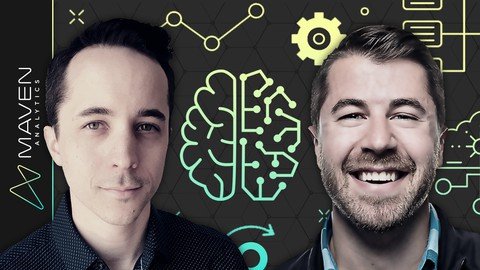
Published 3/2023
MP4 | Video: h264, 1280×720 | Audio: AAC, 44.1 KHz
Language: English | Size: 3.20 GB | Duration: 8h 51m
Explore Data Science & Machine Learning topics with simple, step-by-step demos and user-friendly Excel models (NO code!)
What you’ll learn
Build foundational machine learning & data science skills WITHOUT writing complex code
Play with interactive, user-friendly Excel models to learn how machine learning techniques actually work
Enrich datasets using feature engineering techniques like one-hot encoding, scaling and discretization
Predict categorical outcomes using classification models like K-nearest neighbors, naïve bayes, and decision trees
Build accurate forecasts and projections using linear and non-linear regression models
Apply powerful techniques for clustering, association mining, outlier detection, and dimensionality reduction
Learn how to select and tune models to optimize performance, reduce bias, and minimize drift
Explore unique, hands-on case studies to simulate how machine learning can be applied to real-world cases
Requirements
This is a beginner-friendly course (no prior knowledge or math/stats background required)
We’ll use Microsoft Excel (Office 365) for some course demos, but participation is optional
Description
This course is for everyday people looking for an intuitive, beginner-friendly introduction to the world of machine learning and data science.Build confidence with guided, step-by-step demos, and learn foundational skills from the ground up. Instead of memorizing complex math or learning a new coding language, we’ll break down and explore machine learning techniques to help you understand exactly how and why they work.Follow along with simple, visual examples and interact with user-friendly, Excel-based models to learn topics like linear and logistic regression, decision trees, KNN, naïve bayes, hierarchical clustering, sentiment analysis, and more – without writing a SINGLE LINE of code.This course combines 4 best-selling courses from Maven Analytics into a single masterclass:PART 1: Univariate & Multivariate ProfilingPART 2: Classification ModelingPART 3: Regression & ForecastingPART 4: Unsupervised LearningPART 1: Univariate & Multivariate ProfilingIn Part 1 we’ll introduce the machine learning workflow and common techniques for cleaning and preparing raw data for analysis. We’ll explore univariate analysis with frequency tables, histograms, kernel densities, and profiling metrics, then dive into multivariate profiling tools like heat maps, violin & box plots, scatter plots, and correlation:Section 1: Machine Learning Intro & LandscapeMachine learning process, definition, and landscapeSection 2: Preliminary Data QAVariable types, empty values, range & count calculations, left/right censoring, etc.Section 3: Univariate ProfilingHistograms, frequency tables, mean, median, mode, variance, skewness, etc.Section 4: Multivariate ProfilingViolin & box plots, kernel densities, heat maps, correlation, etc.Throughout the course, we’ll introduce real-world scenarios to solidify key concepts and simulate actual data science and business intelligence cases. You’ll use profiling metrics to clean up product inventory data for a local grocery, explore Olympic athlete demographics with histograms and kernel densities, visualize traffic accident frequency with heat maps, and more.PART 2: Classification ModelingIn Part 2 we’ll introduce the supervised learning landscape, review the classification workflow, and address key topics like dependent vs. independent variables, feature engineering, data splitting and overfitting. From there we’ll review common classification models like K-Nearest Neighbors (KNN), Naïve Bayes, Decision Trees, Random Forests, Logistic Regression and Sentiment Analysis, and share tips for model scoring, selection, and optimization:Section 1: Intro to ClassificationSupervised learning & classification workflow, feature engineering, splitting, overfitting & underfittingSection 2: Classification ModelsK-nearest neighbors, naïve bayes, decision trees, random forests, logistic regression, sentiment analysisSection 3: Model Selection & TuningHyperparameter tuning, imbalanced classes, confusion matrices, accuracy, precision & recall, model driftYou’ll help build a simple recommendation engine for Spotify, analyze customer purchase behavior for a retail shop, predict subscriptions for an online travel company, extract sentiment from a sample of book reviews, and more.PART 3: Regression & ForecastingIn Part 3 we’ll introduce core building blocks like linear relationships and least squared error, and practice applying them to univariate, multivariate, and non-linear regression models. We’ll review diagnostic metrics like R-squared, mean error, F-significance, and P-Values, then use time-series forecasting techniques to identify seasonality, predict nonlinear trends, and measure the impact of key business decisions using intervention analysis:Section 1: Intro to RegressionSupervised learning landscape, regression vs. classification, prediction vs. root-cause analysisSection 2: Regression Modeling 101Linear relationships, least squared error, univariate & multivariate regression, nonlinear transformationSection 3: Model DiagnosticsR-squared, mean error, null hypothesis, F-significance, T & P-values, homoskedasticity, multicollinearitySection 4: Time-Series ForecastingSeasonality, auto correlation, linear trending, non-linear models, intervention analysisYou’ll see how regression analysis can be used to estimate property prices, forecast seasonal trends, predict sales for a new product launch, and even measure the business impact of a new website design.PART 4: Unsupervised LearningIn Part 4 we’ll explore the differences between supervised and unsupervised machine learning and introduce several common unsupervised techniques, including cluster analysis, association mining, outlier detection and dimensionality reduction. We’ll break down each model in simple terms and help you build an intuition for how they work, from K-means and apriori to outlier detection, principal component analysis, and more:Section 1: Intro to Unsupervised Machine LearningUnsupervised learning landscape & workflow, common unsupervised techniques, feature engineeringSection 2: Clustering & SegmentationClustering basics, K-means, elbow plots, hierarchical clustering, dendogramsSection 3: Association MiningAssociation mining basics, apriori, basket analysis, minimum support thresholds, markov chainsSection 4: Outlier DetectionOutlier detection basics, cross-sectional outliers, nearest neighbors, time-series outliers, residual distributionSection 5: Dimensionality ReductionDimensionality reduction basics, principle component analysis (PCA), scree plots, advanced techniquesYou’ll see how K-means can help identify customer segments, how apriori can be used for basket analysis and recommendation engines, and how outlier detection can spot anomalies in cross-sectional or time-series datasets.__________Ready to dive in? Join today and get immediate, LIFETIME access to the following:9+ hours of on-demand videoML Foundations ebook (350+ pages)Downloadable Excel project filesExpert Q&A forum30-day money-back guaranteeIf you’re an analyst or aspiring data professional looking to build the foundation for a successful career in machine learning or data science, you’ve come to the right place.Happy learning!-Josh & Chris
Password/解压密码www.tbtos.com
转载请注明:0daytown » The Complete Visual Guide To Machine Learning & Data Science